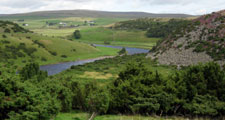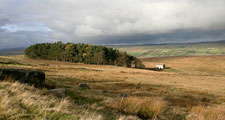Woodlands in North Pennines
Existing Woodland
Woodland cover in the North Pennines is sparse and largely restricted to the moorland margins and to the dales, which are relatively well wooded in their lower reaches. Small gill and riverside woods are typical of the middle dale. There are scattered areas of juniper scrub in the moorland margins, most notably at Holwick in upper Teesdale. Wooded gorges and ravines are a notable feature of lower Teesdale and lower Derwentdale. Small conifer plantations and shelterbelts are common in the lower and middle dales and larger areas of commercial forestry in the moorland fringe.
Native Woods
Upland oak woodlands are found on the glacial drift of the dale floors and the lower dalesides, and upland oak-birch woodlands on the the peaty gleys and podzols of the moorland fringes. Gill and riverside woodlands are typically a mixture of upland ash and oak woodland communities, the alternating strata of Carboniferous rocks giving rise to a variety of ground conditions that are reflected in both the woodland canopy and the ground flora. Upland ash woodlands are found on shallow soils over outcropping limestones, with alder-ash communities on wetter flushed slopes, and oak or oak-birch communities on the more acidic strata and drift. Birch woods are found on very wet ground and are likely to have been more extensive in the past on the fringes of bogs and mires. Juniper scrub occurs in the moorland margins, along becks, gills and crags on a range of calcareous to slightly acidic soils. Alder carr woodland is found on fertile soils on the margins of ponds and wetlands.
Secondary semi-natural woodland and scrub communities are found in abandoned quarries, old railway lines and road verges. These are variable in structure and are typically dominated by pioneer species such as birch, rowan, hawthorn, and shrub willows. A transition between upland oak and ash woodlands and their more diverse lowland counterparts occurs in the lower dale.
Characteristic native woodland types in the North Pennines (identified here by their National Vegetation Class) include:
- Upland Ash Woodland- W9
- Lowland Ash Woodland – NVC W8
- Upland Oak Birch Woodland – W11
- Lowland Oak Woodland – W10
- Upland Oak Birch Woodland – W17
- Alder Ash Woodland – W7
- Alder Carr Woodland – W5
- Birch Woodland – W4
- Juniper Woodland – W19
- Hawthorn Scrub – W21
- Blackthorn Scrub – W22
- Bramble Scrub – W24/25
Information on the typical structure and species composition of these particular native woodland communities, distribution and guidelines on their management, and suitable sites for new planting can be found by clicking on the links above or by downloading the following PDF:
Native Woodland Types (PDF, 598kb)
Semi-natural woodlands in the North Pennines are often small and isolated. Few are actively managed and many suffer from overgrazing by livestock, which inhibits natural regeneration and results in a sparse under storey and ground layer. Juniper scrub in particular is diminishing under grazing pressure. Some ancient woodlands have been replanted with commercial species but retains some of their characteristics and ground flora.
Objectives for native woods in the North Pennines include:
- Conserving semi-natural woodlands and improving their management, and particularly the woods of dale side gills and dale floor gorges.
- Conserving and restoring juniper scrub.
- Restoring replanted or modified ancient woodlands.
Plantations
Most plantations in the North Pennines date from the 19th century and 20th century, although some are contemporary with farms and field walls of the 18th century. Smaller plantations are common in the middle and lower dale. Medium scale plantations, often rectilinear blocks of commercial softwoods, are scattered throughout the moorland fringe and are often associated with reservoirs in tributary dales. There are a small number of larger forestry estates such as Weardale Forest, Hamsterley Forest, and The Stang, in the moorland fringes. Older plantations are often a mixture of broadleaves and conifers with beech, sycamore, oak, scots pine and larch widely planted. Sycamore is common as a shelter tree around farmsteads. In larger plantations conifers, and particularly Sitka spruce, are the dominant species.
There is a long tradition of plantation forestry in the uplands and it is an important component of its landscape character in places. There are circumstances, however, where planting has taken place on important habitats or archaeological features, or with little regard to the underlying topography or character of the landscape. Objectives for plantations in the North Pennines include restructuring commercial plantations to improve their relationship with the surrounding landscape, to restore damaged habitats and archaeological features and to increase their biodiversity. This might include:
- Removing areas of planting (or if necessary whole plantations) from archaeological remains or sensitive habitats like heathland and wetland.
- Conversion of softwood plantations to native woodland – and particularly on sites close to ancient woods.
- Increasing the proportion of native broadleaved species – and particularly along watercourses, margins and rides.
- Redesigning woodland edges and compartments to give a more naturalistic fit with the surrounding landscape.
New Woodland
Planting Sites
Priorities for new planting in the North Pennines include:
Planting in areas where new woodland would strengthen landscape character and enhance biodiversity, and particularly where they would extend or link existing semi-natural woods.
As existing semi-natural woods tend to survive as linear fragments in gills and along watercourses, planting new native woodlands in gills, ravines and river corridors offers the greatest potential for consolidating and linking the woodland habitat network, as well as creating new woods that are characteristic of the local landscape. Extending woodland planting into moorland gills may also be of benefit to certain species, such as black grouse, as may the planting of open woodland or wood pasture in the moorland fringes.
Planting in and around quarries and other mineral workings.
Planting in and around mineral workings can help improve their appearance by screening intrusive features and assimilating artificial landforms. The benefits of woodland planting may need to be balanced against other opportunities for habitat creation, and planting should only take place where woodlands are a characteristic feature of the surrounding local landscape.
Planting around upland reservoirs and water supply infrastructure.
Planting around upland reservoirs can help screen features like draw down zones, dams and infrastructure and help assimilate the reservoir into its surroundings – and particularly where planting is native and naturalistic in design.
Planting areas of juniper scrub, particularly on sites where it has occurred in the past or to consolidate and extend existing sites.
Planting juniper is generally a specialist exercise involving the use of locally grown plant material. Opportunities to plant close to existing juniper woods may be limited. They may be benefits in creating new areas on alternatives sites – like former mineral workings – or incorporating some juniper into planting mixtures for other woodland types.
Care needs to be taken on all sites in this sensitive landscape not to plant on areas of existing ecological or archaeological value. Advice should be taken from Natural England and/or the County Ecologist on sites close to Landscape Designations.
Planting Design
New woodlands should generally have a strong relationship with the underlying topography, following natural gills, steep slopes, river terraces and ravines. In the more ordered landscapes of the lower and middle dale where field patterns are strong, new woodlands should respect and interlock with the field pattern. In the less structured landscapes of gills, dale side bluffs and moorland fringes, naturalistic planting design with areas of open space and varied planting densities will be more appropriate. Fencing should be visually light (post and wire) where possible and avoid skylines.
Species Selection
New planting in the North Pennines should generally be of native species characteristic of the local landscape. The priorities for new woodlands in the area are generally for new native woodlands. For these, existing native woodland types can be used as a guide to species selection.
On the base poor gleys and brown earths, which cover much of the dale floor and lower dale sides, oak (W10) and oak-birch woodlands (W11) would be the most appropriate models for new planting. On poorer soils, humic gleys, rankers & podzols in the moorland fringe, oak-birch (W17) and birch (W4) would be more appropriate. Similar communities could be used in reclaiming acidic mineral wastes and overburdens. On valley sides, gorges and gills where limestones are exposed, and on base rich substrates in limestone quarries, ash and alder-ash communities (W9 and W7) are the most appropriate models. Alder woodlands may be useful models for planting on wet ground within other woodlands (W7), or in association with wetland features (W5 W6) or on land subject to seasonal flooding (W6). The planting of juniper scrub (W19) is generally a specialist exercise.
Further Information
View an interactive map of the distribution of Native Woodland Types in County Durham.



